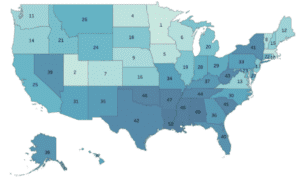Study identifies the best and worst states for millennials across seven key factors Millennials have quickly become the leading generation of the United States over the past few years. This generation, born from 1981 to 1996, will become leaders in the workplace, and the biggest contributors to the economy. They will also continue to be political leaders and the drivers of social change. As they work towards this, it is important for millennials to live in the best environment.

They have experienced slower economic growth than their preceding and subsequent generations due to the multiple recessions that hit them at the highest points of their lifetimes. With the rising cost of living and inflation, as well as the impact of a global pandemic, there are a number of challenges to U.S. millennials that will influence where they will live, work and dream.
Scholaroo’s new report on the best and worst states for millennials gathered data on 52 metrics that impact this generation’s decision on where to live. Considerations such as the cost of living, homeownership rate, unemployment rate, and median student loan debt, amongst other factors. The study compared all 50 states and ranked them from best to worst for millennials.

While the living standards and economic situation for many have declined over the last two years, some states proved to be more livable for millennials than others, the study found.
In order to determine the best and worst states for millennials, Scholaroo compared the 50 states across seven key dimensions:
- Affordability
- Employment
- Health
- Personal
- Finance
- Political & Social Environment
- Quality of Life
- Safety
Those dimensions were then evaluated using 52 relevant metrics and each metric was graded on a 100-point scale, with a score of 100 being the max. (Visit: scholaroo.com/report/best-states-for-millennials for specifics.)
To summarize the findings, the study determined each state’s weighted average across all metrics to calculate its overall score.




